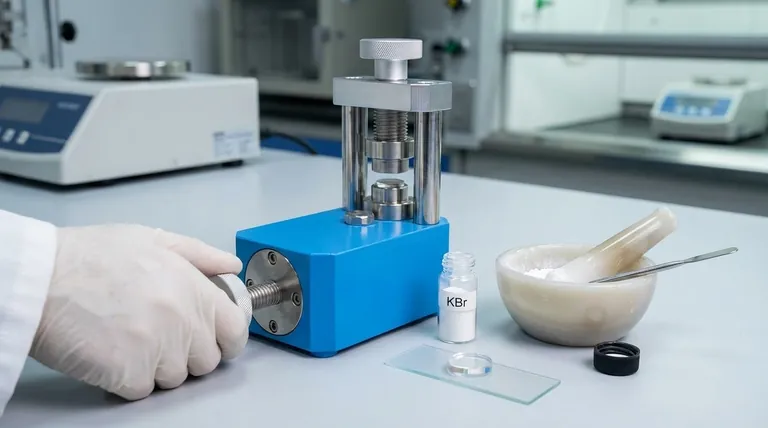簡単に言うと、KBrディスク法は、赤外(IR)分光法で固体試料を分析するために使用される一般的な試料調製技術です。少量の固体試料を臭化カリウム(KBr)粉末と細かく粉砕し、その混合物を高圧下で圧縮して薄く透明なディスクまたはペレットを形成します。このペレットは、分析のために分光計の赤外線ビームの経路に直接置くことができます。
従来のIR分光法で固体試料を分析する際の中心的な課題は、通常、それらが不透明であることです。KBr法は、試料をIR光に対して透明なKBrマトリックス内に分散させることでこれを克服し、不透明な粉末を測定用の半透明な窓に効果的に変えます。
原理:なぜこの方法が必要なのか
なぜ固体には特別なアプローチが必要なのか
赤外分光法は、IR光のビームを試料に通過させ、どの波長が吸収されるかを測定することによって機能します。これが機能するためには、試料が少なくとも部分的に光に対して透明でなければなりません。
ほとんどの固体材料、特に粉末状のものは不透明であり、IRビームを単に遮断したり散乱させたりするため、標準的な透過測定は不可能です。
臭化カリウム(KBr)の独特な役割
KBr法は、臭化カリウムのようなアルカリハライドの物理的特性を巧みに利用しています。KBrは、主に2つの理由から理想的なマトリックス材料です。
- IR透過性:中赤外領域では光を吸収しないため、試料自身の吸収ピークを見るための明確な「窓」を提供します。
- 圧力下の可塑性:KBr粉末は、巨大な圧力を受けると流動し、融合して固体でガラスのようなシートになり、その中に試料粒子を閉じ込めます。
分析用窓の作成
試料を非常に細かい粒子に粉砕し、KBr粉末全体に均一に分散させることで、均質な混合物が作成されます。これをプレスすると、試料が透明なKBrマトリックス中に懸濁された固体ディスクが形成され、IRビームが通過して試料分子と相互作用できるようになります。

調製プロセス:高品質なスペクトルを得るための重要なステップ
ステップ1:綿密な粉砕
試料は、はるかに多量の純粋で乾燥したKBr粉末と混合されます。その後、混合物はめのう乳鉢と乳棒で徹底的に粉砕されます。
目標は、試料の粒子サイズを使用するIR放射の波長よりも小さくすることです。これにより、光が粒子から散乱するのを防ぎ、結果として得られるスペクトルが歪むのを防ぎます。
ステップ2:ダイへの充填
細かく粉砕された混合物の少量分を、専用のペレットダイに慎重に充填します。ダイは完全に清潔であることが重要です。なぜなら、いかなる汚染物質も最終的なスペクトルに現れるからです。
ステップ3:ペレットのプレス
ダイを油圧プレスにセットし、数トンの力を加えます。この巨大な圧力により、KBrが塑性変形し、固体で透明なペレットが形成されます。
多くの場合、これは真空下で行われます。真空は、閉じ込められた空気、そしてより重要なことに、測定を妨げる可能性のある残留水分を除去するのに役立ちます。
ステップ4:バックグラウンド補正
試料ペレットを測定する前に、「ブランク」が実行されることがよくあります。これは、空のビーム経路であるか、理想的には純粋なKBrのみで作られたペレットです。
このバックグラウンドスペクトルは、試料のスペクトルから差し引かれ、大気中のCO2、水蒸気、またはKBr自体の不純物からの干渉信号を電子的に除去します。
トレードオフと落とし穴の理解
湿気の問題
臭化カリウムは吸湿性であり、大気中の水分を容易に吸収します。この吸収された水分は、スペクトルに非常に広くて強い吸収ピークを生成し、実際の試料の重要な特徴を容易に不明瞭にする可能性があります。乾燥したKBrを使用し、ペレットを迅速に調製することが重要です。
散乱効果(クリスチャンセン効果)
試料が十分に細かく粉砕されていない場合、粒子はIR光を吸収するのではなく散乱させます。これにより、ベースラインが歪み、真の吸収ピークを正確に特定することが困難になる可能性があります。適切な粉砕が唯一の解決策です。
圧力誘起変化
ペレットを形成するために使用される高圧は、試料材料の結晶構造(多形)を変化させることがあります。これは、結果として得られるスペクトルが、元の状態の試料を完全に表していない可能性があることを意味します。
分析に適した選択をする
意味のあるデータを得るためには、正しいサンプリング方法を選択することが不可欠です。
- 安定した固体の高品質な透過スペクトルに重点を置く場合:KBrディスク法は、正しく実行されれば、古典的で強力かつ費用対効果の高い選択肢です。
- 試料が圧力や湿気に敏感な場合:最小限の準備で試料表面を直接分析する減衰全反射(ATR)のような、代替の非破壊的な方法を検討してください。
- 定量分析を行う必要がある場合:KBr法は、再現性のある結果を得るために、ペレットの厚さと試料濃度を非常に正確に制御する必要があることに注意してください。
この技術を習得することで、幅広い固体材料の化学的指紋を解き明かす信頼性の高い方法が提供されます。
要約表:
| 主要な側面 | 説明 |
|---|---|
| 目的 | IR光に対して透明にすることで、IR分光法における固体試料を分析すること。 |
| 核心原理 | 微細な粉末試料を、IR放射に対して透明な臭化カリウム(KBr)マトリックス中に分散させる。 |
| 主要なステップ | 粉砕、KBrとの混合、高圧下でのペレット化、およびバックグラウンド補正。 |
| 主な利点 | 安定した固体材料に対して高品質な透過スペクトルを提供する。 |
| 主な課題 | 湿気感受性(KBrは吸湿性)、粒子散乱、および潜在的な圧力誘起変化。 |
固体試料分析で優れた結果を達成する準備はできていますか?
KBrディスク法は、信頼性の高いIR分光法のための基本的な技術です。正確で再現性のある結果を得るためには、適切な機器が不可欠です。KINTEKは、試料調製ニーズをサポートするために、信頼性の高いペレットダイやプレスを含む高品質な実験装置と消耗品を提供することに特化しています。
今すぐお問い合わせください。当社のソリューションがお客様のラボの効率とデータ品質をどのように向上させることができるかについてご相談ください。当社の専門家が、お客様の用途に最適な機器の選択をお手伝いします。
ビジュアルガイド

関連製品
- kbrペレットプレス 2t
- ラボラトリー油圧プレス 分割式電動ラボペレットプレス
- ラボ用自動油圧ペレットプレス機
- ラボ用油圧ペレットプレス実験装置
- 実験室用油圧ペレットプレス(XRF KBR FTIR実験室用途)



















